
莲喇母矮将贸多大学 高级商务英语阅读 Chapter 12 Long Live the Revolution 1.教学目的 通过本文的学习,使学生了解到历史上两次技术革新带给商业模式的巨大革命,并使他们进一步 认识到新的管理模式下供应链结构的不同变化,并从经济和技术发展的进程启发学生对经济和管理 规模发展趋势的预测,并加深学生对我国改革开放历史意义的理解。本文涉及到许多经贸知识,如: 供应链、库存周转率、规模经济、产业调整等内容的基本概念学生也应掌握。另外,增强学生对上 述内容的英语术语表达也是本课的教学目的之一。 Ⅱ.教学计划 拟使用四课时完成本课内容。一课时介绍背景知识,两课时用于课文讲解及难点讨论,最后一 课时可就某一相关问题(如:供应链上出现的两次革命及技术革新对产业结构的影响等)展开讨论。 川.教学方法 以学生为中心,通过师生互动、各抒己见的方式理解和认识课文中涉及到的各类问题(也包括 语言方面的问题)。 IV.背景知识 1.About the author: 1)Dr.Narendra Agrawal Dr.Naren Agrawal is an associate professor in the Department of Operations Management Information Systems of Santa Clara University,and has been a visiting associate professor at the Wharton School of Business.He also worked as Systems Analyst with Tata Consultancy Services in Bombay,India.Prof.Agrawal teaches courses in supply chain management,operations management,computer based decision models,and manufacturing competitiveness in the MBA and executive MBA programs.His research interests include supply chain management,sourcing strategy,design and analysis of distribution systems,and manufacturing competitiveness.His research has been published in journals such as Operations Research,Manufacturing and Service Operations Management,Naval Research Logistics,IIE Transactions,and the Journal of Retailing He has also contributed chapters in a number of books on supply chain management.He serves 第1页共13页
高级商务英语阅读 Chapter 12 Long Live the Revolution I.教学目的 通过本文的学习,使学生了解到历史上两次技术革新带给商业模式的巨大革命,并使他们进一步 认识到新的管理模式下供应链结构的不同变化,并从经济和技术发展的进程启发学生对经济和管理 规模发展趋势的预测,并加深学生对我国改革开放历史意义的理解。本文涉及到许多经贸知识,如: 供应链、库存周转率、规模经济、产业调整等内容的基本概念学生也应掌握。另外,增强学生对上 述内容的英语术语表达也是本课的教学目的之一。 II.教学计划 拟使用四课时完成本课内容。一课时介绍背景知识,两课时用于课文讲解及难点讨论,最后一 课时可就某一相关问题(如:供应链上出现的两次革命及技术革新对产业结构的影响等)展开讨论。 III.教学方法 以学生为中心,通过师生互动、各抒己见的方式理解和认识课文中涉及到的各类问题(也包括 语言方面的问题)。 IV.背景知识 1. About the author: 1) Dr. Narendra Agrawal Dr. Naren Agrawal is an associate professor in the Department of Operations & Management Information Systems of Santa Clara University, and has been a visiting associate professor at the Wharton School of Business. He also worked as Systems Analyst with Tata Consultancy Services in Bombay, India. Prof. Agrawal teaches courses in supply chain management, operations management, computer based decision models, and manufacturing competitiveness in the MBA and executive MBA programs. His research interests include supply chain management, sourcing strategy, design and analysis of distribution systems, and manufacturing competitiveness. His research has been published in journals such as Operations Research, Manufacturing and Service Operations Management, Naval Research Logistics, IIE Transactions, and the Journal of Retailing. He has also contributed chapters in a number of books on supply chain management. He serves 第 1 页 共 13 页
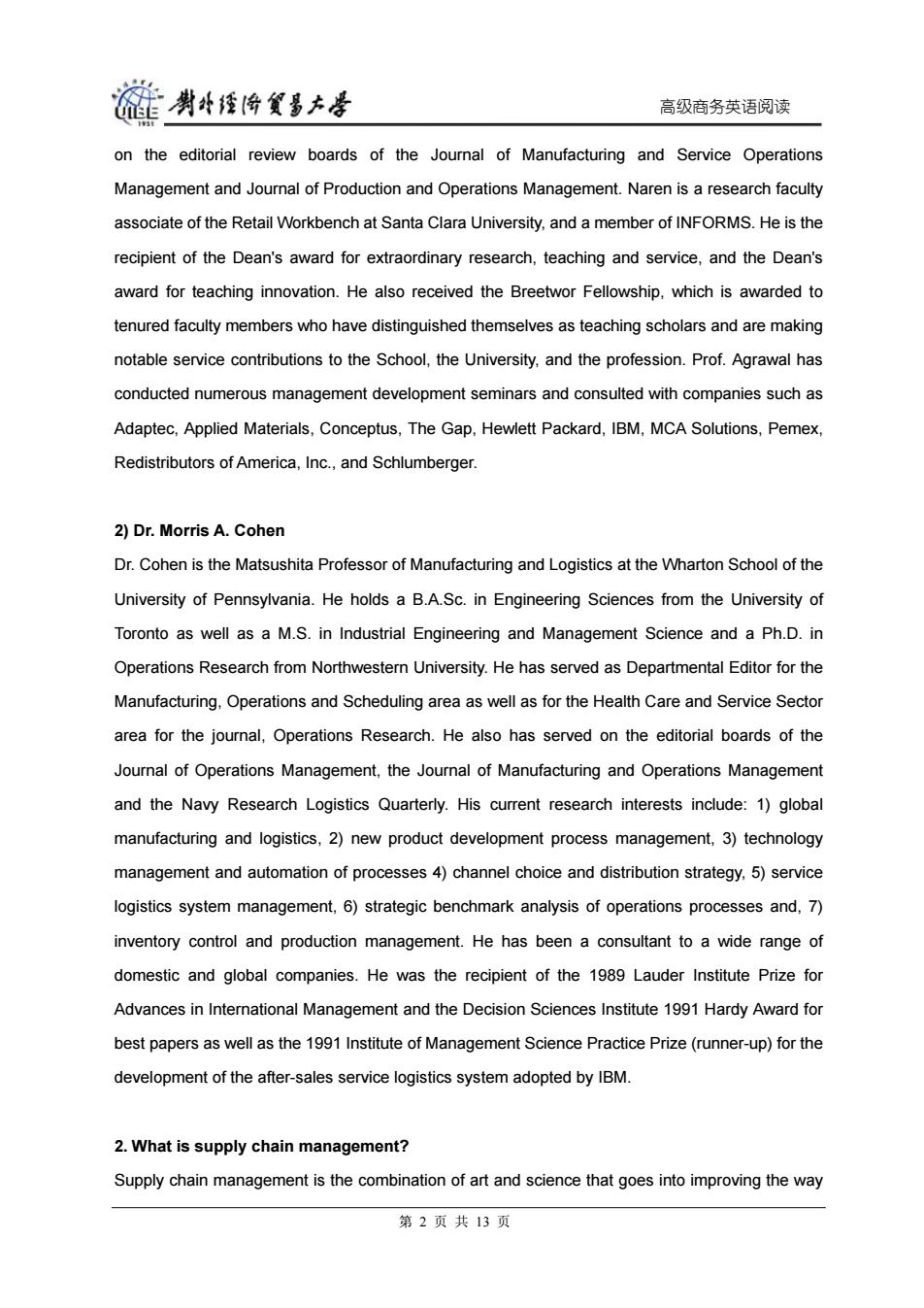
链勇经份贸多大圣 高级商务英语阅读 on the editorial review boards of the Journal of Manufacturing and Service Operations Management and Journal of Production and Operations Management.Naren is a research faculty associate of the Retail Workbench at Santa Clara University,and a member of INFORMS.He is the recipient of the Dean's award for extraordinary research,teaching and service,and the Dean's award for teaching innovation.He also received the Breetwor Fellowship,which is awarded to tenured faculty members who have distinguished themselves as teaching scholars and are making notable service contributions to the School,the University,and the profession.Prof.Agrawal has conducted numerous management development seminars and consulted with companies such as Adaptec,Applied Materials,Conceptus,The Gap,Hewlett Packard,IBM,MCA Solutions,Pemex, Redistributors of America,Inc.,and Schlumberger. 2)Dr.Morris A.Cohen Dr.Cohen is the Matsushita Professor of Manufacturing and Logistics at the Wharton School of the University of Pennsylvania.He holds a B.A.Sc.in Engineering Sciences from the University of Toronto as well as a M.S.in Industrial Engineering and Management Science and a Ph.D.in Operations Research from Northwestern University.He has served as Departmental Editor for the Manufacturing,Operations and Scheduling area as well as for the Health Care and Service Sector area for the journal,Operations Research.He also has served on the editorial boards of the Journal of Operations Management,the Journal of Manufacturing and Operations Management and the Navy Research Logistics Quarterly.His current research interests include:1)global manufacturing and logistics,2)new product development process management,3)technology management and automation of processes 4)channel choice and distribution strategy,5)service logistics system management,6)strategic benchmark analysis of operations processes and,7) inventory control and production management.He has been a consultant to a wide range of domestic and global companies.He was the recipient of the 1989 Lauder Institute Prize for Advances in International Management and the Decision Sciences Institute 1991 Hardy Award for best papers as well as the 1991 Institute of Management Science Practice Prize(runner-up)for the development of the after-sales service logistics system adopted by IBM. 2.What is supply chain management? Supply chain management is the combination of art and science that goes into improving the way 第2页共13页
高级商务英语阅读 on the editorial review boards of the Journal of Manufacturing and Service Operations Management and Journal of Production and Operations Management. Naren is a research faculty associate of the Retail Workbench at Santa Clara University, and a member of INFORMS. He is the recipient of the Dean's award for extraordinary research, teaching and service, and the Dean's award for teaching innovation. He also received the Breetwor Fellowship, which is awarded to tenured faculty members who have distinguished themselves as teaching scholars and are making notable service contributions to the School, the University, and the profession. Prof. Agrawal has conducted numerous management development seminars and consulted with companies such as Adaptec, Applied Materials, Conceptus, The Gap, Hewlett Packard, IBM, MCA Solutions, Pemex, Redistributors of America, Inc., and Schlumberger. 2) Dr. Morris A. Cohen Dr. Cohen is the Matsushita Professor of Manufacturing and Logistics at the Wharton School of the University of Pennsylvania. He holds a B.A.Sc. in Engineering Sciences from the University of Toronto as well as a M.S. in Industrial Engineering and Management Science and a Ph.D. in Operations Research from Northwestern University. He has served as Departmental Editor for the Manufacturing, Operations and Scheduling area as well as for the Health Care and Service Sector area for the journal, Operations Research. He also has served on the editorial boards of the Journal of Operations Management, the Journal of Manufacturing and Operations Management and the Navy Research Logistics Quarterly. His current research interests include: 1) global manufacturing and logistics, 2) new product development process management, 3) technology management and automation of processes 4) channel choice and distribution strategy, 5) service logistics system management, 6) strategic benchmark analysis of operations processes and, 7) inventory control and production management. He has been a consultant to a wide range of domestic and global companies. He was the recipient of the 1989 Lauder Institute Prize for Advances in International Management and the Decision Sciences Institute 1991 Hardy Award for best papers as well as the 1991 Institute of Management Science Practice Prize (runner-up) for the development of the after-sales service logistics system adopted by IBM. 2. What is supply chain management? Supply chain management is the combination of art and science that goes into improving the way 第 2 页 共 13 页
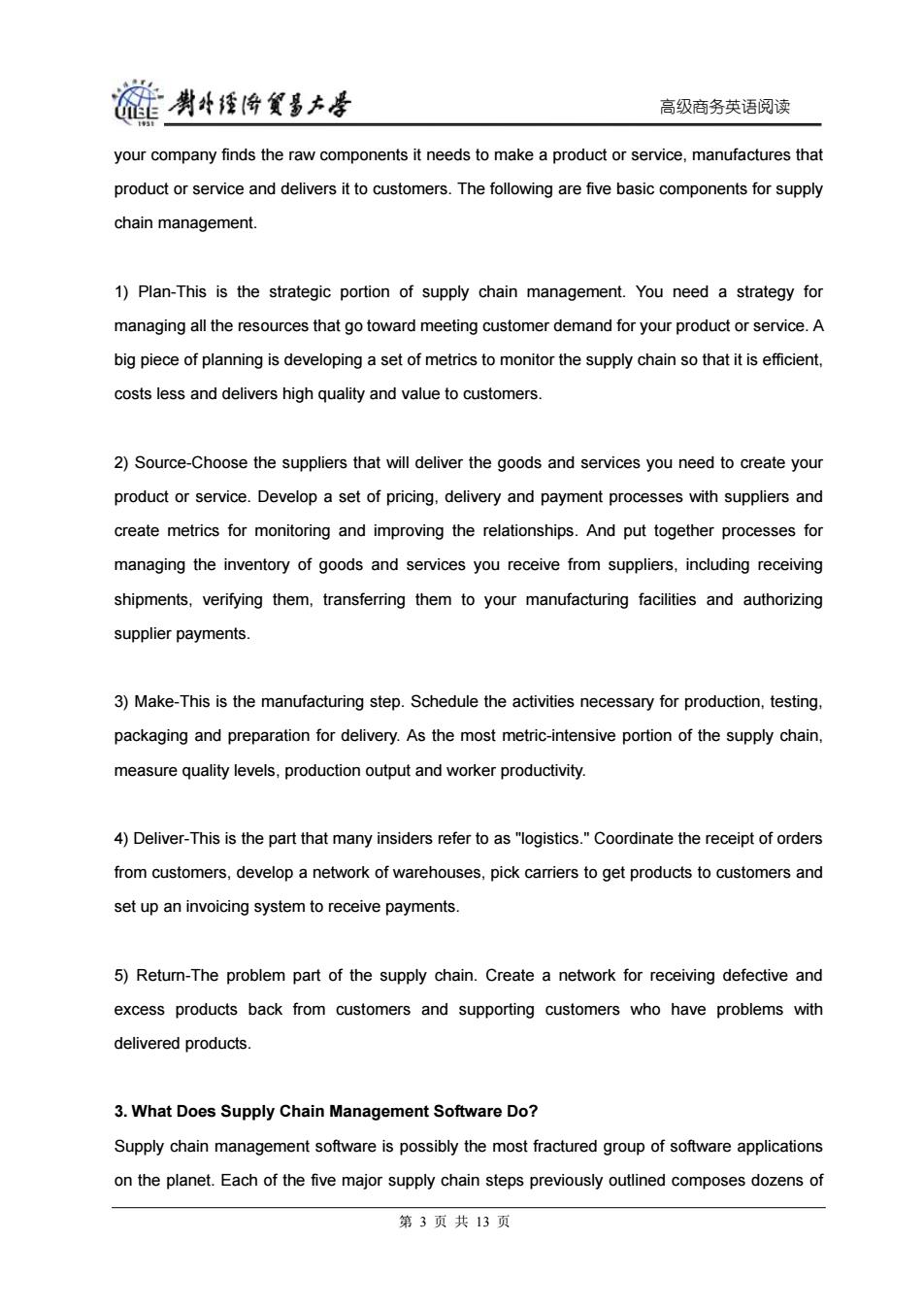
醛肖经海食多大是 高级商务英语阅读 your company finds the raw components it needs to make a product or service,manufactures that product or service and delivers it to customers.The following are five basic components for supply chain management. 1)Plan-This is the strategic portion of supply chain management.You need a strategy for managing all the resources that go toward meeting customer demand for your product or service.A big piece of planning is developing a set of metrics to monitor the supply chain so that it is efficient, costs less and delivers high quality and value to customers. 2)Source-Choose the suppliers that will deliver the goods and services you need to create your product or service.Develop a set of pricing,delivery and payment processes with suppliers and create metrics for monitoring and improving the relationships.And put together processes for managing the inventory of goods and services you receive from suppliers,including receiving shipments,verifying them,transferring them to your manufacturing facilities and authorizing supplier payments. 3)Make-This is the manufacturing step.Schedule the activities necessary for production,testing, packaging and preparation for delivery.As the most metric-intensive portion of the supply chain, measure quality levels,production output and worker productivity. 4)Deliver-This is the part that many insiders refer to as"logistics."Coordinate the receipt of orders from customers,develop a network of warehouses,pick carriers to get products to customers and set up an invoicing system to receive payments. 5)Return-The problem part of the supply chain.Create a network for receiving defective and excess products back from customers and supporting customers who have problems with delivered products. 3.What Does Supply Chain Management Software Do? Supply chain management software is possibly the most fractured group of software applications on the planet.Each of the five major supply chain steps previously outlined composes dozens of 第3页共13页
高级商务英语阅读 your company finds the raw components it needs to make a product or service, manufactures that product or service and delivers it to customers. The following are five basic components for supply chain management. 1) Plan-This is the strategic portion of supply chain management. You need a strategy for managing all the resources that go toward meeting customer demand for your product or service. A big piece of planning is developing a set of metrics to monitor the supply chain so that it is efficient, costs less and delivers high quality and value to customers. 2) Source-Choose the suppliers that will deliver the goods and services you need to create your product or service. Develop a set of pricing, delivery and payment processes with suppliers and create metrics for monitoring and improving the relationships. And put together processes for managing the inventory of goods and services you receive from suppliers, including receiving shipments, verifying them, transferring them to your manufacturing facilities and authorizing supplier payments. 3) Make-This is the manufacturing step. Schedule the activities necessary for production, testing, packaging and preparation for delivery. As the most metric-intensive portion of the supply chain, measure quality levels, production output and worker productivity. 4) Deliver-This is the part that many insiders refer to as "logistics." Coordinate the receipt of orders from customers, develop a network of warehouses, pick carriers to get products to customers and set up an invoicing system to receive payments. 5) Return-The problem part of the supply chain. Create a network for receiving defective and excess products back from customers and supporting customers who have problems with delivered products. 3. What Does Supply Chain Management Software Do? Supply chain management software is possibly the most fractured group of software applications on the planet. Each of the five major supply chain steps previously outlined composes dozens of 第 3 页 共 13 页
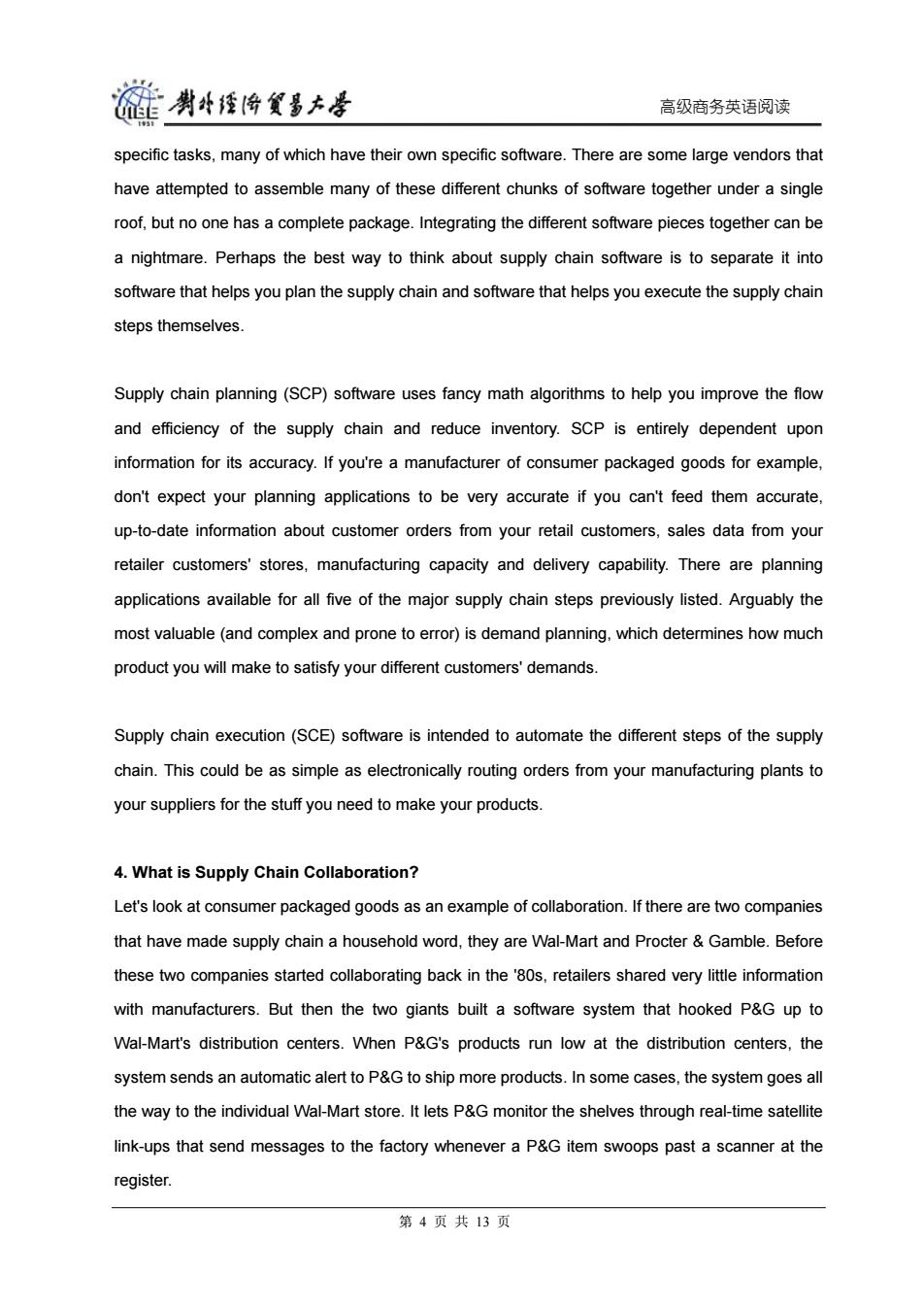
链剥挂将发多大是 高级商务英语阅读 specific tasks,many of which have their own specific software.There are some large vendors that have attempted to assemble many of these different chunks of software together under a single roof,but no one has a complete package.Integrating the different software pieces together can be a nightmare.Perhaps the best way to think about supply chain software is to separate it into software that helps you plan the supply chain and software that helps you execute the supply chain steps themselves. Supply chain planning(SCP)software uses fancy math algorithms to help you improve the flow and efficiency of the supply chain and reduce inventory.SCP is entirely dependent upon information for its accuracy.If you're a manufacturer of consumer packaged goods for example, don't expect your planning applications to be very accurate if you can't feed them accurate, up-to-date information about customer orders from your retail customers,sales data from your retailer customers'stores,manufacturing capacity and delivery capability.There are planning applications available for all five of the major supply chain steps previously listed.Arguably the most valuable(and complex and prone to error)is demand planning,which determines how much product you will make to satisfy your different customers'demands. Supply chain execution(SCE)software is intended to automate the different steps of the supply chain.This could be as simple as electronically routing orders from your manufacturing plants to your suppliers for the stuff you need to make your products. 4.What is Supply Chain Collaboration? Let's look at consumer packaged goods as an example of collaboration.If there are two companies that have made supply chain a household word,they are Wal-Mart and Procter Gamble.Before these two companies started collaborating back in the '80s,retailers shared very little information with manufacturers.But then the two giants built a software system that hooked P&G up to Wal-Mart's distribution centers.When P&G's products run low at the distribution centers,the system sends an automatic alert to P&G to ship more products.In some cases,the system goes all the way to the individual Wal-Mart store.It lets P&G monitor the shelves through real-time satellite link-ups that send messages to the factory whenever a P&G item swoops past a scanner at the register. 第4页共13页
高级商务英语阅读 specific tasks, many of which have their own specific software. There are some large vendors that have attempted to assemble many of these different chunks of software together under a single roof, but no one has a complete package. Integrating the different software pieces together can be a nightmare. Perhaps the best way to think about supply chain software is to separate it into software that helps you plan the supply chain and software that helps you execute the supply chain steps themselves. Supply chain planning (SCP) software uses fancy math algorithms to help you improve the flow and efficiency of the supply chain and reduce inventory. SCP is entirely dependent upon information for its accuracy. If you're a manufacturer of consumer packaged goods for example, don't expect your planning applications to be very accurate if you can't feed them accurate, up-to-date information about customer orders from your retail customers, sales data from your retailer customers' stores, manufacturing capacity and delivery capability. There are planning applications available for all five of the major supply chain steps previously listed. Arguably the most valuable (and complex and prone to error) is demand planning, which determines how much product you will make to satisfy your different customers' demands. Supply chain execution (SCE) software is intended to automate the different steps of the supply chain. This could be as simple as electronically routing orders from your manufacturing plants to your suppliers for the stuff you need to make your products. 4. What is Supply Chain Collaboration? Let's look at consumer packaged goods as an example of collaboration. If there are two companies that have made supply chain a household word, they are Wal-Mart and Procter & Gamble. Before these two companies started collaborating back in the '80s, retailers shared very little information with manufacturers. But then the two giants built a software system that hooked P&G up to Wal-Mart's distribution centers. When P&G's products run low at the distribution centers, the system sends an automatic alert to P&G to ship more products. In some cases, the system goes all the way to the individual Wal-Mart store. It lets P&G monitor the shelves through real-time satellite link-ups that send messages to the factory whenever a P&G item swoops past a scanner at the register. 第 4 页 共 13 页
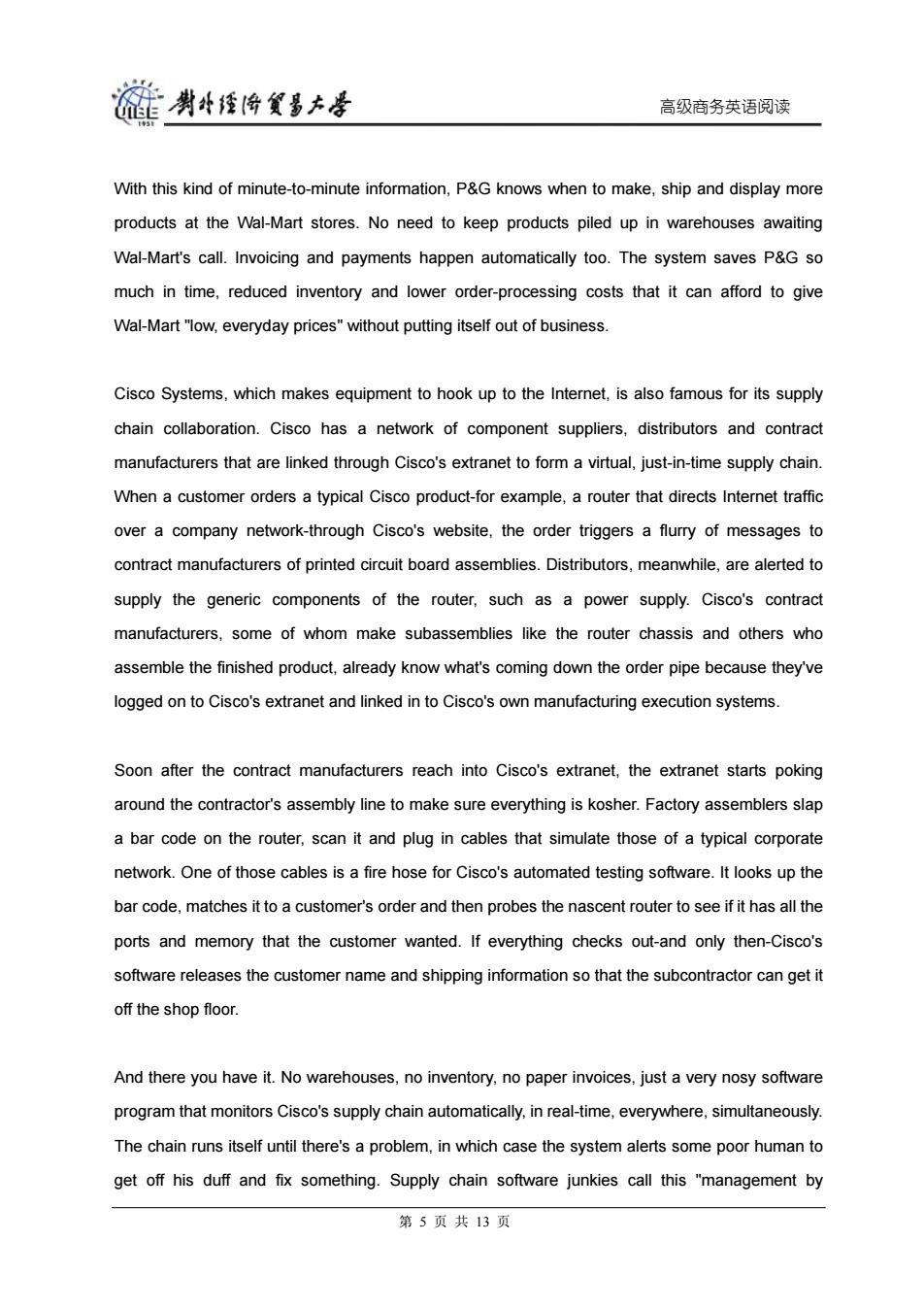
能男华经降贸多大星 高级商务英语阅读 With this kind of minute-to-minute information,P&G knows when to make,ship and display more products at the Wal-Mart stores.No need to keep products piled up in warehouses awaiting Wal-Mart's call.Invoicing and payments happen automatically too.The system saves P&G so much in time,reduced inventory and lower order-processing costs that it can afford to give Wal-Mart "low,everyday prices"without putting itself out of business. Cisco Systems,which makes equipment to hook up to the Internet,is also famous for its supply chain collaboration.Cisco has a network of component suppliers,distributors and contract manufacturers that are linked through Cisco's extranet to form a virtual,just-in-time supply chain. When a customer orders a typical Cisco product-for example,a router that directs Internet traffic over a company network-through Cisco's website,the order triggers a flurry of messages to contract manufacturers of printed circuit board assemblies.Distributors,meanwhile,are alerted to supply the generic components of the router,such as a power supply.Cisco's contract manufacturers,some of whom make subassemblies like the router chassis and others who assemble the finished product,already know what's coming down the order pipe because they've logged on to Cisco's extranet and linked in to Cisco's own manufacturing execution systems. Soon after the contract manufacturers reach into Cisco's extranet,the extranet starts poking around the contractor's assembly line to make sure everything is kosher.Factory assemblers slap a bar code on the router,scan it and plug in cables that simulate those of a typical corporate network.One of those cables is a fire hose for Cisco's automated testing software.It looks up the bar code,matches it to a customer's order and then probes the nascent router to see if it has all the ports and memory that the customer wanted.If everything checks out-and only then-Cisco's software releases the customer name and shipping information so that the subcontractor can get it off the shop floor. And there you have it.No warehouses,no inventory,no paper invoices,just a very nosy software program that monitors Cisco's supply chain automatically,in real-time,everywhere,simultaneously. The chain runs itself until there's a problem,in which case the system alerts some poor human to get off his duff and fix something.Supply chain software junkies call this "management by 第5页共13页
高级商务英语阅读 With this kind of minute-to-minute information, P&G knows when to make, ship and display more products at the Wal-Mart stores. No need to keep products piled up in warehouses awaiting Wal-Mart's call. Invoicing and payments happen automatically too. The system saves P&G so much in time, reduced inventory and lower order-processing costs that it can afford to give Wal-Mart "low, everyday prices" without putting itself out of business. Cisco Systems, which makes equipment to hook up to the Internet, is also famous for its supply chain collaboration. Cisco has a network of component suppliers, distributors and contract manufacturers that are linked through Cisco's extranet to form a virtual, just-in-time supply chain. When a customer orders a typical Cisco product-for example, a router that directs Internet traffic over a company network-through Cisco's website, the order triggers a flurry of messages to contract manufacturers of printed circuit board assemblies. Distributors, meanwhile, are alerted to supply the generic components of the router, such as a power supply. Cisco's contract manufacturers, some of whom make subassemblies like the router chassis and others who assemble the finished product, already know what's coming down the order pipe because they've logged on to Cisco's extranet and linked in to Cisco's own manufacturing execution systems. Soon after the contract manufacturers reach into Cisco's extranet, the extranet starts poking around the contractor's assembly line to make sure everything is kosher. Factory assemblers slap a bar code on the router, scan it and plug in cables that simulate those of a typical corporate network. One of those cables is a fire hose for Cisco's automated testing software. It looks up the bar code, matches it to a customer's order and then probes the nascent router to see if it has all the ports and memory that the customer wanted. If everything checks out-and only then-Cisco's software releases the customer name and shipping information so that the subcontractor can get it off the shop floor. And there you have it. No warehouses, no inventory, no paper invoices, just a very nosy software program that monitors Cisco's supply chain automatically, in real-time, everywhere, simultaneously. The chain runs itself until there's a problem, in which case the system alerts some poor human to get off his duff and fix something. Supply chain software junkies call this "management by 第 5 页 共 13 页

碰男降贸多大是 高级商务英语阅读 exception."You don't need to do anything unless there is something wrong. If there's a weakness to these collaborative systems,it's that they haven't been tested in tough times-until recently.Cisco's network was designed to handle the company's huge growth. Distributed decision making is great if the decisions have mostly to do with making and selling more things.But Cisco and its network were caught completely off guard by the recent tumble in the economy.It took awhile to turn all the spigots off in its complex network when demand for its products plummeted and Cisco and its supply chain partners got stuck with a lot of excess inventory-as did most other big manufacturers in high technology.Cisco was forced to take a hard look at its supply chain planning capability.SCP software is much better at managing growth than it is at monitoring a decline and correcting it. 5.New Technology Determining the Successful Supply Chain Management The past 10 years have not seen much improvement in reducing inventory levels.Rather than being eliminated,inventory has been pushed down from manufacturers to top-tier suppliers to lower-tier suppliers.This is a lose-lose proposition,and CIOs are looking to new technologies that can provide the information needed to eliminate inventory and drive out costs.Demand-planning software digs out the information buried in a company's databases and turns it into reports on sales trends.Cashman Equipment,a $250 million Las Vegas-based Caterpillar dealership,used a $12,000 demand-planning package to achieve an $8 million reduction in inventory in the first month of operation.Supply chain visibility software and replenishment planning software have also paid off for companies.Smaller,more focused inventory management applications are generally working better and faster than big scope implementations. E-procurement sounds like purchase only.If you throw into it the selling as the other half,it will sound more like B2B.Some of the companies offer you customized catalogs and customized Ul; allowing you not only to purchase,but punch-in/punch-out and sales.In fact,with one of the e-procurement products,with a little more effort,both halves within a large enterprise can be setup fairly easily. 6.E-Procurement 第6页共13页
高级商务英语阅读 exception." You don't need to do anything unless there is something wrong. If there's a weakness to these collaborative systems, it's that they haven't been tested in tough times-until recently. Cisco's network was designed to handle the company's huge growth. Distributed decision making is great if the decisions have mostly to do with making and selling more things. But Cisco and its network were caught completely off guard by the recent tumble in the economy. It took awhile to turn all the spigots off in its complex network when demand for its products plummeted and Cisco and its supply chain partners got stuck with a lot of excess inventory-as did most other big manufacturers in high technology. Cisco was forced to take a hard look at its supply chain planning capability. SCP software is much better at managing growth than it is at monitoring a decline and correcting it. 5. New Technology Determining the Successful Supply Chain Management The past 10 years have not seen much improvement in reducing inventory levels. Rather than being eliminated, inventory has been pushed down from manufacturers to top-tier suppliers to lower-tier suppliers. This is a lose-lose proposition, and CIOs are looking to new technologies that can provide the information needed to eliminate inventory and drive out costs. Demand-planning software digs out the information buried in a company's databases and turns it into reports on sales trends. Cashman Equipment, a $250 million Las Vegas-based Caterpillar dealership, used a $12,000 demand-planning package to achieve an $8 million reduction in inventory in the first month of operation. Supply chain visibility software and replenishment planning software have also paid off for companies. Smaller, more focused inventory management applications are generally working better and faster than big scope implementations. E-procurement sounds like purchase only. If you throw into it the selling as the other half, it will sound more like B2B. Some of the companies offer you customized catalogs and customized UI; allowing you not only to purchase, but punch-in/punch-out and sales. In fact, with one of the e-procurement products, with a little more effort, both halves within a large enterprise can be setup fairly easily. 6. E-Procurement 第 6 页 共 13 页

链男母经降贸多大量 高级商务英语阅读 At Applied Industrial Technologies,price negotiation remains in the hands of the product managers in charge of each category.The focus of the company's e-procurement is on making internal processes more efficient through the paperless processing of orders,receipts and invoices.An internally developed inventory management application gathers requirements from more than 400 Applied service centers across Canada,Mexico,Puerto Rico and the United States,and then sends them to suppliers via EDI. This isn't rocket science,but it meets the needs of the $1.5 billion distributor of industrial components that stocks 2 million different items,including bearings,motors,pumps,valves, couplings and the other highly substitutable building blocks of manufactured products.And those blocks are provided by suppliers competing in an intensely price-sensitive market.Applied CIO Jim Hopper eschews newer technologies like XML in favor of tried-and-trusted EDI because,as he says,EDI"has been around for 20 years,works and is very cheap for us to administer.There's a ton of people who know EDI intimately but only a handful who know XML that well. "We'll do EDI with anyone that has the capability,"adds Hopper,"and help them to get that capability if they haven't got it." Similarly,Webasto Roof Systems,a $300 million subsidiary of Germany-based automobile roof and thermo systems manufacturer Webasto AG,has been adopting e-procurement strategies to make its internal process more efficient,while keeping sourcing decisions and price negotiations offline. CIO Mike Thibideau credits e-procurement with reducing inventories by 15 percent,generating $1.5 million of cash flow and reducing annual inventory carrying costs by $180,000.All that,and the system is still only 30 percent implemented. Using technology developed by enterprise system vendor QAD,Webasto's 150 direct material suppliers download all the information they need to know to ship the parts and materials for Webasto's sunroofs and convertible tops.Because all they need is a Web-browser,it's less intrusive than EDl,and less expensive-especially for the supplier,who doesn't have to pay 第7页共13页
高级商务英语阅读 At Applied Industrial Technologies, price negotiation remains in the hands of the product managers in charge of each category. The focus of the company's e-procurement is on making internal processes more efficient through the paperless processing of orders, receipts and invoices. An internally developed inventory management application gathers requirements from more than 400 Applied service centers across Canada, Mexico, Puerto Rico and the United States, and then sends them to suppliers via EDI. This isn't rocket science, but it meets the needs of the $1.5 billion distributor of industrial components that stocks 2 million different items, including bearings, motors, pumps, valves, couplings and the other highly substitutable building blocks of manufactured products. And those blocks are provided by suppliers competing in an intensely price-sensitive market. Applied CIO Jim Hopper eschews newer technologies like XML in favor of tried-and-trusted EDI because, as he says, EDI "has been around for 20 years, works and is very cheap for us to administer. There's a ton of people who know EDI intimately but only a handful who know XML that well. "We'll do EDI with anyone that has the capability," adds Hopper, "and help them to get that capability if they haven't got it." Similarly, Webasto Roof Systems, a $300 million subsidiary of Germany-based automobile roof and thermo systems manufacturer Webasto AG, has been adopting e-procurement strategies to make its internal process more efficient, while keeping sourcing decisions and price negotiations offline. CIO Mike Thibideau credits e-procurement with reducing inventories by 15 percent, generating $1.5 million of cash flow and reducing annual inventory carrying costs by $180,000. All that, and the system is still only 30 percent implemented. Using technology developed by enterprise system vendor QAD, Webasto's 150 direct material suppliers download all the information they need to know to ship the parts and materials for Webasto's sunroofs and convertible tops. Because all they need is a Web-browser, it's less intrusive than EDI, and less expensive—especially for the supplier, who doesn't have to pay 第 7 页 共 13 页
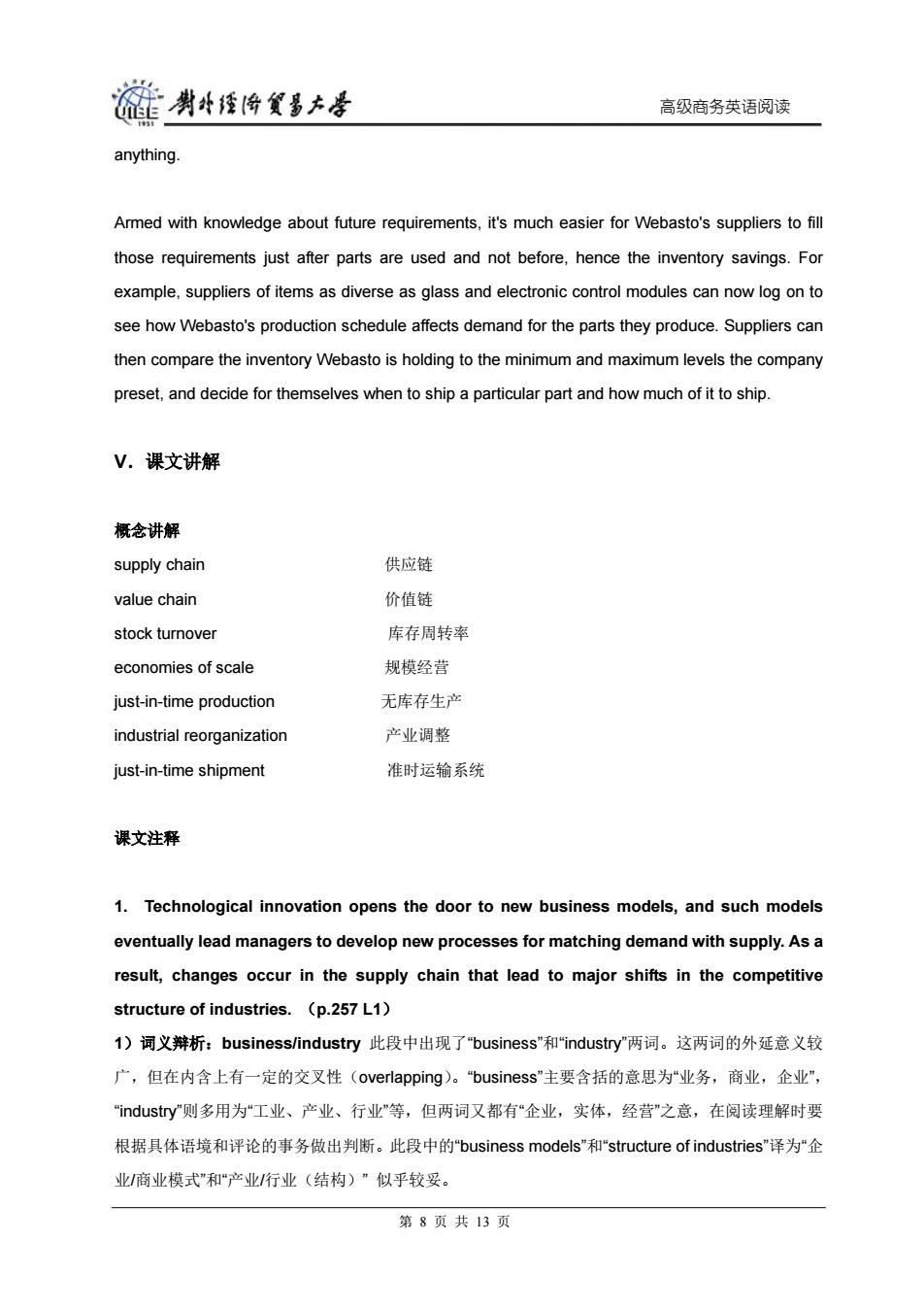
碰男经降贸多大量 高级商务英语阅读 anything. Armed with knowledge about future requirements,it's much easier for Webasto's suppliers to fill those requirements just after parts are used and not before,hence the inventory savings.For example,suppliers of items as diverse as glass and electronic control modules can now log on to see how Webasto's production schedule affects demand for the parts they produce.Suppliers can then compare the inventory Webasto is holding to the minimum and maximum levels the company preset,and decide for themselves when to ship a particular part and how much of it to ship. V.课文讲解 概念讲解 supply chain 供应链 value chain 价值链 stock turnover 库存周转率 economies of scale 规模经营 just-in-time production 无库存生产 industrial reorganization 产业调整 just-in-time shipment 准时运输系统 课文注释 1.Technological innovation opens the door to new business models,and such models eventually lead managers to develop new processes for matching demand with supply.As a result,changes occur in the supply chain that lead to major shifts in the competitive structure of industries.(p.257 L1) 1)词义辩析:business/industry此段中出现了“business"和“industry'"两词。这两词的外延意义较 广,但在内含上有一定的交叉性(overlapping)。“business"主要含括的意思为“业务,商业,企业”, “industry'则多用为“工业、产业、行业”等,但两词又都有“企业,实体,经营”之意,在阅读理解时要 根据具体语境和评论的事务做出判断。此段中的business models"和“structure of industries"译为“企 业商业模式”和“产业行业(结构)”似乎较妥。 第8页共13页
高级商务英语阅读 anything. Armed with knowledge about future requirements, it's much easier for Webasto's suppliers to fill those requirements just after parts are used and not before, hence the inventory savings. For example, suppliers of items as diverse as glass and electronic control modules can now log on to see how Webasto's production schedule affects demand for the parts they produce. Suppliers can then compare the inventory Webasto is holding to the minimum and maximum levels the company preset, and decide for themselves when to ship a particular part and how much of it to ship. V.课文讲解 概念讲解 supply chain 供应链 value chain 价值链 stock turnover 库存周转率 economies of scale 规模经营 just-in-time production 无库存生产 industrial reorganization 产业调整 just-in-time shipment 准时运输系统 课文注释 1. Technological innovation opens the door to new business models, and such models eventually lead managers to develop new processes for matching demand with supply. As a result, changes occur in the supply chain that lead to major shifts in the competitive structure of industries. (p.257 L1) 1)词义辩析:business/industry 此段中出现了“business”和“industry”两词。这两词的外延意义较 广,但在内含上有一定的交叉性(overlapping)。“business”主要含括的意思为“业务,商业,企业”, “industry”则多用为“工业、产业、行业”等,但两词又都有“企业,实体,经营”之意,在阅读理解时要 根据具体语境和评论的事务做出判断。此段中的“business models”和“structure of industries”译为“企 业/商业模式”和“产业/行业(结构)” 似乎较妥。 第 8 页 共 13 页
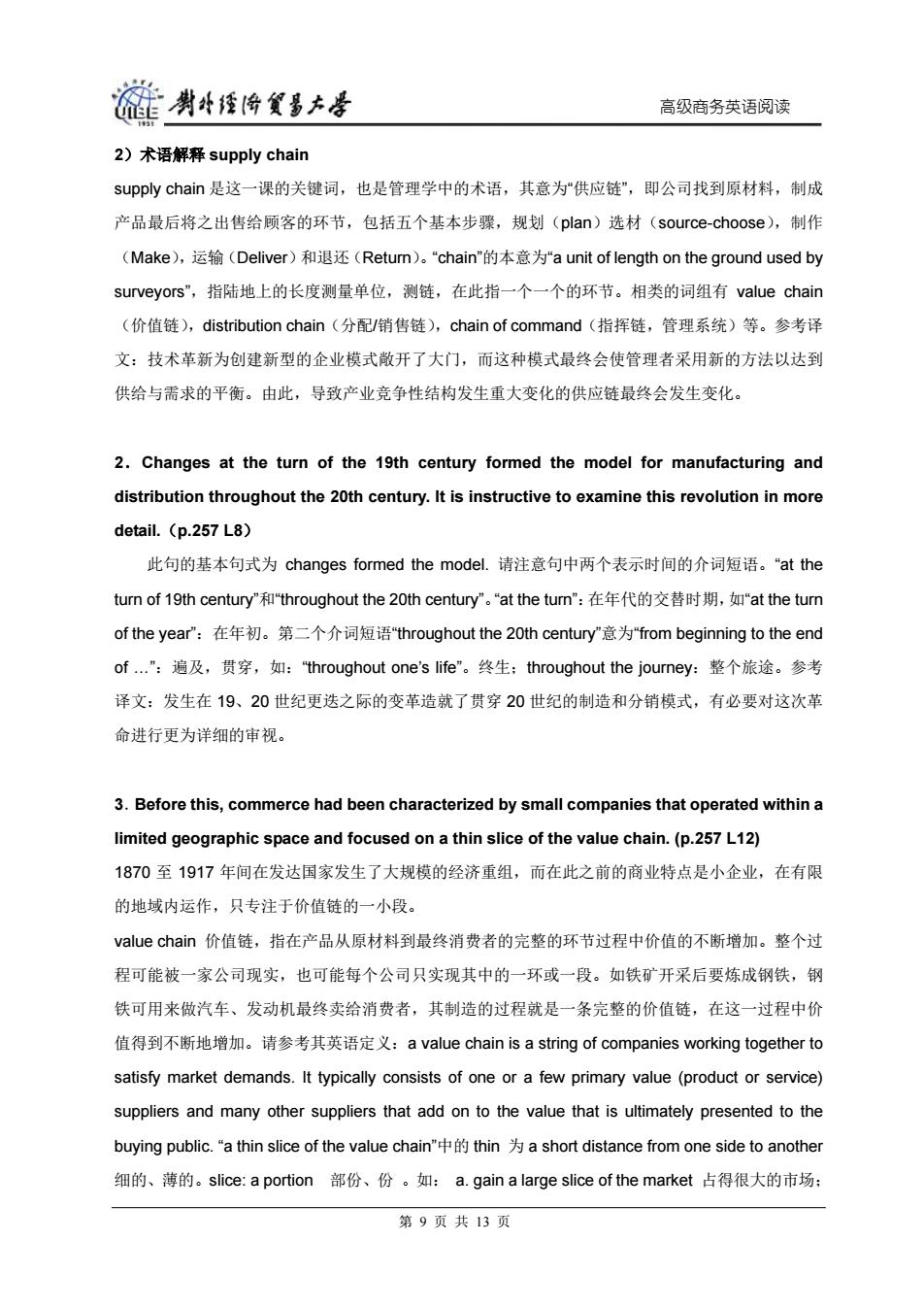
链剥挂将发多大是 高级商务英语阅读 2)术语解释supply chain supply chain是这一课的关键词,也是管理学中的术语,其意为“供应链”,即公司找到原材料,制成 产品最后将之出售给顾客的环节,包括五个基本步骤,规划(plan)选材(source-choose),制作 (Make),运输(Deliver)和退还(Return)。“chain'"的本意为“a unit of length on the ground used by surveyors'”,指陆地上的长度测量单位,测链,在此指一个一个的环节。相类的词组有value chain (价值链),distribution chain(分配/销售链),chain of command(指挥链,管理系统)等。参考译 文:技术革新为创建新型的企业模式敞开了大门,而这种模式最终会使管理者采用新的方法以达到 供给与需求的平衡。由此,导致产业竞争性结构发生重大变化的供应链最终会发生变化。 2.Changes at the turn of the 19th century formed the model for manufacturing and distribution throughout the 20th century.It is instructive to examine this revolution in more detail.(p.257 L8) 此句的基本句式为changes formed the model.请注意句中两个表示时间的介词短语。“at the turn of19 th century"和“"throughout the2 Oth century”。“at the turn”:在年代的交替时期,如“at the turn of the year'":在年初。第二个介词短语"throughout the2 Oth century"意为"'from beginning to the end of”:遍及,贯穿,如:“throughout one's life”。终生;throughout the journey:整个旅途。参考 译文:发生在19、20世纪更迭之际的变革造就了贯穿20世纪的制造和分销模式,有必要对这次革 命进行更为详细的审视。 3.Before this,commerce had been characterized by small companies that operated within a limited geographic space and focused on a thin slice of the value chain.(p.257 L12) 1870至1917年间在发达国家发生了大规模的经济重组,而在此之前的商业特点是小企业,在有限 的地域内运作,只专注于价值链的一小段。 value chain价值链,指在产品从原材料到最终消费者的完整的环节过程中价值的不断增加。整个过 程可能被一家公司现实,也可能每个公司只实现其中的一环或一段。如铁矿开采后要炼成钢铁,钢 铁可用来做汽车、发动机最终卖给消费者,其制造的过程就是一条完整的价值链,在这一过程中价 值得到不断地增加。请参考其英语定义:a value chain is a string of companies working together to satisfy market demands.It typically consists of one or a few primary value(product or service) suppliers and many other suppliers that add on to the value that is ultimately presented to the buying public."a thin slice of the value chain"thin a short distance from one side to another 细的、薄的。slice:a portion部份、份。如:a.gain a large slice of the market占得很大的市场: 第9页共13页
高级商务英语阅读 2)术语解释 supply chain supply chain 是这一课的关键词,也是管理学中的术语,其意为“供应链”,即公司找到原材料,制成 产品最后将之出售给顾客的环节,包括五个基本步骤,规划(plan)选材(source-choose),制作 (Make),运输(Deliver)和退还(Return)。“chain”的本意为“a unit of length on the ground used by surveyors”,指陆地上的长度测量单位,测链,在此指一个一个的环节。相类的词组有 value chain (价值链),distribution chain(分配/销售链),chain of command(指挥链,管理系统)等。参考译 文:技术革新为创建新型的企业模式敞开了大门,而这种模式最终会使管理者采用新的方法以达到 供给与需求的平衡。由此,导致产业竞争性结构发生重大变化的供应链最终会发生变化。 2.Changes at the turn of the 19th century formed the model for manufacturing and distribution throughout the 20th century. It is instructive to examine this revolution in more detail.(p.257 L8) 此句的基本句式为 changes formed the model. 请注意句中两个表示时间的介词短语。“at the turn of 19th century”和“throughout the 20th century”。“at the turn”:在年代的交替时期,如“at the turn of the year”:在年初。第二个介词短语“throughout the 20th century”意为“from beginning to the end of …”:遍及,贯穿,如:“throughout one’s life”。终生;throughout the journey:整个旅途。参考 译文:发生在 19、20 世纪更迭之际的变革造就了贯穿 20 世纪的制造和分销模式,有必要对这次革 命进行更为详细的审视。 3.Before this, commerce had been characterized by small companies that operated within a limited geographic space and focused on a thin slice of the value chain. (p.257 L12) 1870 至 1917 年间在发达国家发生了大规模的经济重组,而在此之前的商业特点是小企业,在有限 的地域内运作,只专注于价值链的一小段。 value chain 价值链,指在产品从原材料到最终消费者的完整的环节过程中价值的不断增加。整个过 程可能被一家公司现实,也可能每个公司只实现其中的一环或一段。如铁矿开采后要炼成钢铁,钢 铁可用来做汽车、发动机最终卖给消费者,其制造的过程就是一条完整的价值链,在这一过程中价 值得到不断地增加。请参考其英语定义:a value chain is a string of companies working together to satisfy market demands. It typically consists of one or a few primary value (product or service) suppliers and many other suppliers that add on to the value that is ultimately presented to the buying public. “a thin slice of the value chain”中的 thin 为 a short distance from one side to another 细的、薄的。slice: a portion 部份、份 。如: a. gain a large slice of the market 占得很大的市场; 第 9 页 共 13 页

碰男降贸多大是 高级商务英语阅读 b.claim a slice of the profit要求分得一份利润。这里“a thin slice of the value chain"可译为价值链 的一小段。 4.During this period these companies were replaced by large,vertically integrated corporations.(p.257 L15) Vertically integrated(or vertical integration):the form of integration by which an industrial concern obtains control of the business that supplies most of its materials(called backward integration)or of the business that buys most of its products,i.e.its customers(called forward integration).纵向合并、 纵向一体化、纵向整合,重直一体化。通过这种一体化形式,一个工业联合企业取得向它供应大部 分材料的企业的控制(叫做后向合并),或购买其大部分产品的企业(亦即其顾客)的控制(叫做前 向合并),在课文中,“integrated”可理解为“联合”或“整合”。此句参考译文:在此期间,这些小企业被 大型的、垂直一体化的公司所代替。 5.What were the technologies that enabled the movement to the "visible hand"to take place?(p.258 L8) visible hand"是相对于经济学家亚当·斯史密提出的“invisible hand”(看不见的手)来说的。亚当·斯 史密认为:in a free market,,no regulation of any type would be needed to ensure that the mutually beneficial exchange of goods and services took place,since this "invisible hand"would guide market participants of trade in the most mutually beneficial manner. 这里,作者借用“invisible hand"的相反意义,表示经济领域产品的分配权利已从自由市场转到了管理 者(invisible hand)手中。 6.The scale and complexity of business increased,necessitating the invention of management skills such as scheduling,accounting and co-ordination across many interacting locations.(p.258 L13) interacting locations:中的“interact”or“interactive'”源自于电脑词汇,本意为“相互作用的,交互式 的”,表示每一个步骤并不跟随着一整套序列,而是每一步骤均由其前一步骤所决定。这里可译作“互 动地点”,表示决定一个地点后而代动或影响另一个或几个地点。相似结构的术语还有如interactive behavior相互行为,指销售商与其潜在顾客、个人或公司之间的行为。本句参考译文:企业的规模 和复杂程度增加必然促进了诸如规划、核算和许多互动地点之间协调的管理技术的发明。 第10页共13页
高级商务英语阅读 b. claim a slice of the profit 要求分得一份利润。这里“a thin slice of the value chain”可译为价值链 的一小段。 4.During this period these companies were replaced by large, vertically integrated corporations. (p.257 L15) Vertically integrated (or vertical integration): the form of integration by which an industrial concern obtains control of the business that supplies most of its materials (called backward integration) or of the business that buys most of its products, i.e. its customers (called forward integration).纵向合并、 纵向一体化、纵向整合,重直一体化。通过这种一体化形式,一个工业联合企业取得向它供应大部 分材料的企业的控制(叫做后向合并),或购买其大部分产品的企业(亦即其顾客)的控制(叫做前 向合并),在课文中,“integrated”可理解为“联合”或“整合”。此句参考译文:在此期间,这些小企业被 大型的、垂直一体化的公司所代替。 5.What were the technologies that enabled the movement to the “visible hand” to take place? (p.258 L8) “visible hand”是相对于经济学家亚当·斯史密提出的“invisible hand”(看不见的手)来说的。亚当·斯 史密认为:in a free market, no regulation of any type would be needed to ensure that the mutually beneficial exchange of goods and services took place, since this “invisible hand” would guide market participants of trade in the most mutually beneficial manner. 这里,作者借用“invisible hand”的相反意义,表示经济领域产品的分配权利已从自由市场转到了管理 者(invisible hand)手中。 6 . The scale and complexity of business increased, necessitating the invention of management skills such as scheduling, accounting and co-ordination across many interacting locations. (p.258 L13) interacting locations :中的 “interact” or “interactive”源自于电脑词汇,本意为“相互作用的,交互式 的”,表示每一个步骤并不跟随着一整套序列,而是每一步骤均由其前一步骤所决定。这里可译作“互 动地点”,表示决定一个地点后而代动或影响另一个或几个地点。相似结构的术语还有如 interactive behavior 相互行为,指销售商与其潜在顾客、个人或公司之间的行为。本句参考译文:企业的规模 和复杂程度增加必然促进了诸如规划、核算和许多互动地点之间协调的管理技术的发明。 第 10 页 共 13 页